| Author |
 Topic Topic  |
|
|
Stargazer 40
    
USA
431 Posts |
 Posted - 11/10/2018 : 09:58:23 Posted - 11/10/2018 : 09:58:23


|
I wanted to start a new thread as this will affect a number of GQ meters. Basically I'm evaluating the dead time correction, but also using it to hone in on correct conversion and dead time numbers in an attempt to get to the best set of numbers for the meters to match a known standard commercial geiger counter, the Mazur 9000.
My setup is simple. I put the 5uCi source between two stacks of match boxes. Three boxes tall is Position #3. Two boxes tall is Position #2. A single box is Position #1. To maximize the Mazur performance I added a pad of sticky notes to each single match box for Position #1+. The meter is of course laid face down across the boxes and centered on the source.
Image Insert:
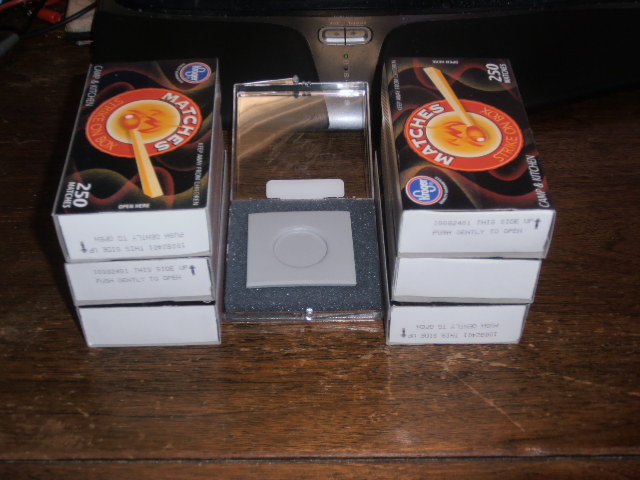
79661 bytes
Image Insert:
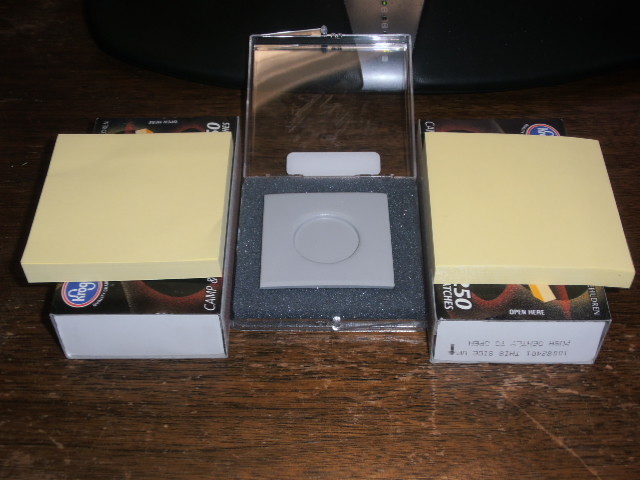
79938 bytes
The Mazur meter uses a two point calibration. I will be using three points to calibrate the 600+ to the Mazur 9000. Then I will use the 600+ to calibrate the 600 and the 500+ meters. I set up a matrix in a spreadsheet to show conversion and dead time that best fit. Took awhile but here is the table for the Mazur and 600+ without and with dead time correction. I also added the 10uCi source to the list in Position #1 to see how robust the counter is in these meters. (Pretty darn robust!)
Image Insert:
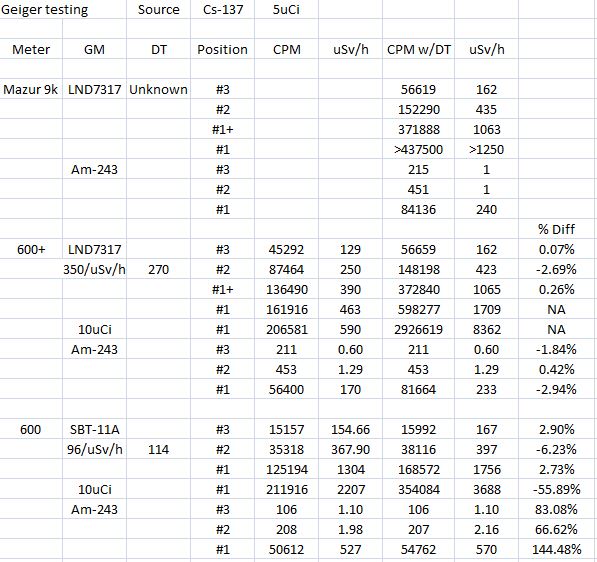
40142 bytes
I have screen shots of all these and will append in additional replies. I think the excellent agreement says we're not seeing much difference in how the counters work or in how the dead time is computed.
|
Stargazer 40 |
Edited by - Stargazer 40 on 11/10/2018 10:02:15
|
|
| Reply #1
Stargazer 40
    
USA
431 Posts |
 Posted - 11/10/2018 : 10:08:01 Posted - 11/10/2018 : 10:08:01


|
Here are the Mazur screens
Image Insert:
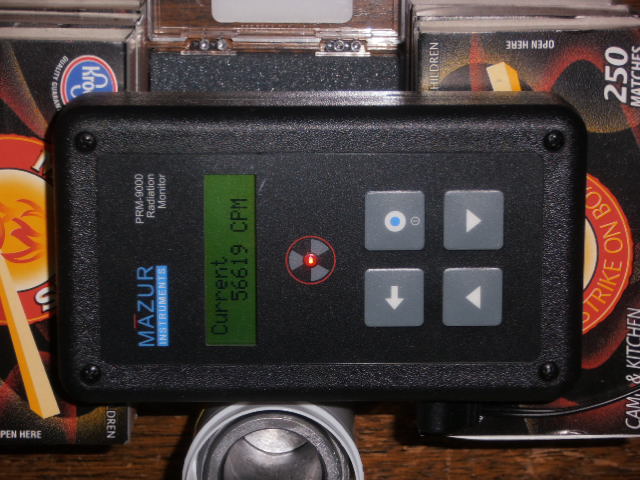
73607 bytes
Image Insert:
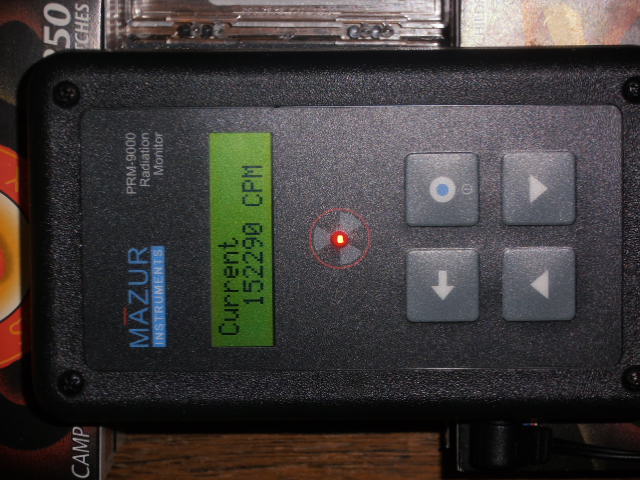
69587 bytes
Image Insert:
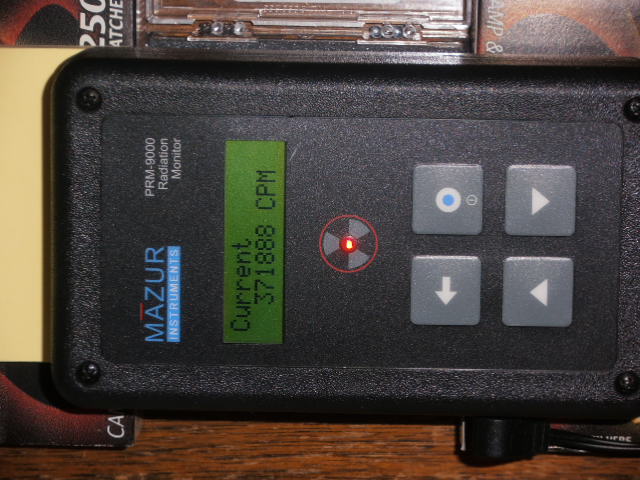
69974 bytes |
Stargazer 40 |
 |
|
| Reply #2
Stargazer 40
    
USA
431 Posts |
 Posted - 11/10/2018 : 10:13:03 Posted - 11/10/2018 : 10:13:03


|
600+ without Dead Time correction
Image Insert:

78605 bytes
Image Insert:
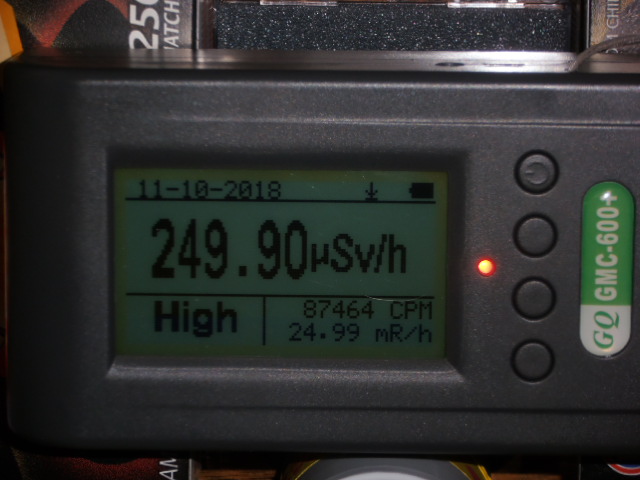
80533 bytes
Image Insert:
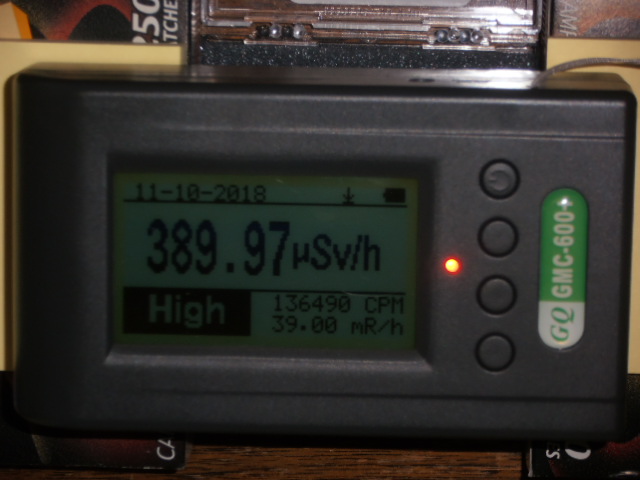
80228 bytes
Image Insert:
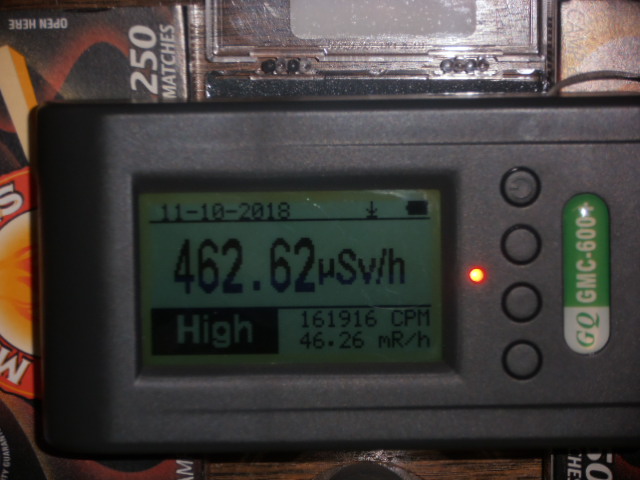
79563 bytes
Image Insert:
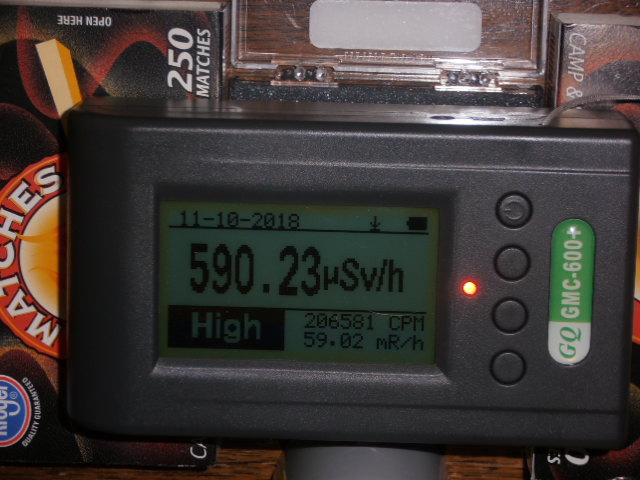
74524 bytes |
Stargazer 40 |
 |
|
| Reply #3
Stargazer 40
    
USA
431 Posts |
 Posted - 11/10/2018 : 10:16:26 Posted - 11/10/2018 : 10:16:26


|
600+ with Dead Time correction
Image Insert:
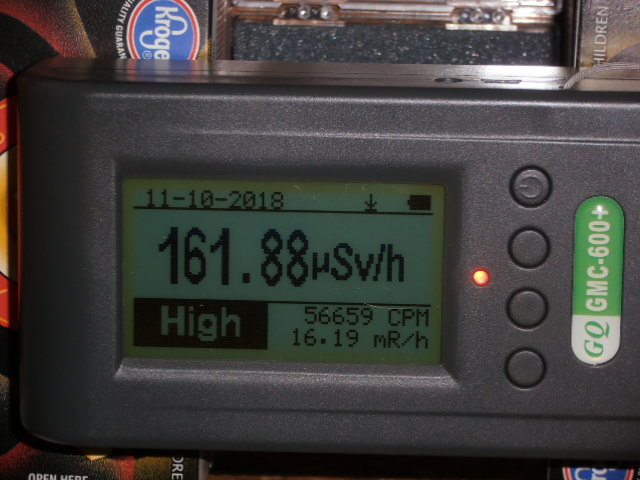
73305 bytes
Image Insert:
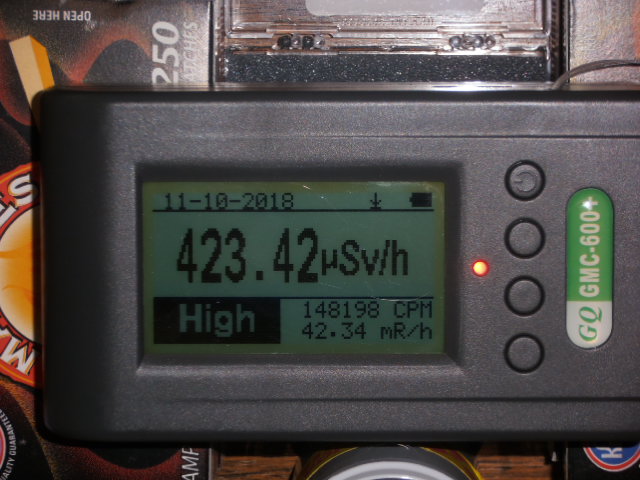
76454 bytes
Image Insert:
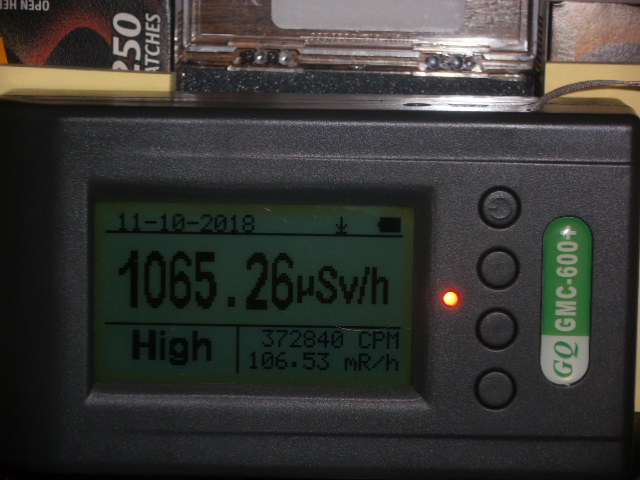
73885 bytes
Image Insert:
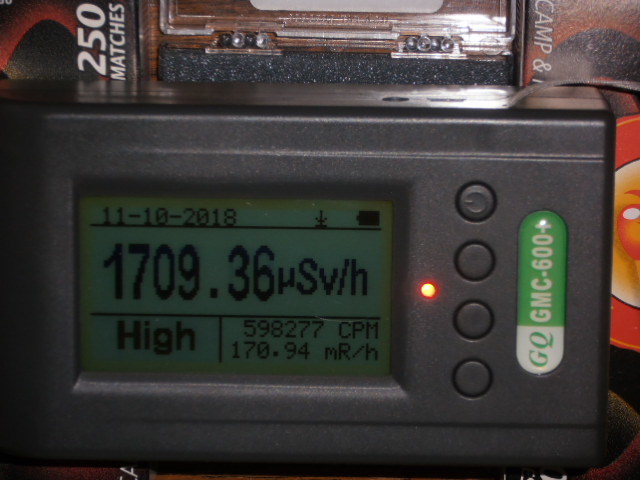
77492 bytes
Image Insert:

74960 bytes |
Stargazer 40 |
 |
|
| Reply #4
ikerrg
    
United Kingdom
334 Posts |
 Posted - 11/10/2018 : 11:52:54 Posted - 11/10/2018 : 11:52:54


|
Thanks for sharing this, Stargazer_40. It is an impressive battery of tests that finally confirms the accuracy of the GMC-6XX counters due to the addition of the dead time (it was so difficult to convince GQ of adding that!). I'd love to see how the GMC-500+ compare (calibrate) to that, so here are some hints for the comparison:
- The source is Cs-137, which emits beta and gamma. Both radiations are detectable by the cylindrical and the pancake tubes, so that is OK. In order to calibrate the 500+ with the 600+ readings in terms of uSv/h dose rate (only valid for the Cs-137 radiation) you will need to be sure that the radiation is homogeneous on the 600+ pancake tube and on the 500+ tubes (one at a time), so you will probably need to put the source in the position #3 or even further away. The radiation will be weaker (due to distance and air attenuation of the beta), but the comparison between the cylindrical and pancake tubes will be better.
- To calibrate the 500+ you can change the dead time (if the effect is not negligible) or the uSv/h/CPM calibration factor. It is difficult to know which one to change in the 500+ to match the uSv/h reading in the 600+ if you only use one distance. I recommend to measure also at a distance where the dead time effect on the 500+ is negligible (less than 30 kCPM) and then adjust the uSv/h/CPM calibration factor at that reading. To tune the dead time put the meters at a distance where the 500+ CPM reading is high enough so the dead time makes a difference (remember that the radiation needs to affect the whole tube geometry).
- You have to repeat this both for the M4011 and the SI-3BG tubes independently. The SI-3BG is low sensitivity, but it can be located closer to the radiation source as its size is small to be homogeneously affected.
My recommendation, time permitting, is that you do all the previous process also when shielding all the betas from the Cs-137 source. Then we will have a better approximation to the real uSv/h/CPM calibration factor to mixed gamma sources of 32 and 661 keV (see the gamma spectrum in https://en.wikipedia.org/wiki/Caesium-137 ).
By the way, congratulations, you are doing a great job and helping a lot GQ with their products (and all the users of course). You are very lucky to have access to those radioactive sources in the US.
|
Edited by - ikerrg on 11/10/2018 11:56:17 |
 |
|
| Reply #5
Stargazer 40
    
USA
431 Posts |
 Posted - 11/11/2018 : 03:56:42 Posted - 11/11/2018 : 03:56:42


|
@ikerrg, thanks for your thoughts. You outlined pretty much the approach I have been taking for the 600 series as a mixed radiation type and energy level calibration. We are fortunate that it is relatively easy to filter out the radiation that we don't want to look at. (I am looking into a clip-on steel shield that will wrap the bottom and two sides of the 500 and 600 cases to act as a beta shield. The simple u-shaped piece of steel sheet would work pretty well for blocking betas. Manufacture would take some kind of shear to cut flat sheets and then a folding device. We'll see.) I think from a priority standpoint I will remain focused on the mixed energies approach until I get each meter calibrated. Then return to the alpha measures (need to do this with the Mazur before I return to my friend) for the 600 and 600+ (and LND712), and finally work on the gammas.
From a First Responder standpoint, the primary mission is to save lives, and then put out the fire or deal with other issues. It is not to characterize radiation types. Only to know that there is potential danger from radiation. The US EPA states 50-100 mSv/h normally would not result in any harm. When chatting with the meter calibration gentleman in North Carolina, he mentioned that First Responder agencies that he calibrates for are really only interested in when they need to turn back. 300-500mSv/h is what they want to be aware of. After calibration I will be setting the High CPM indicator to the CPM that gives me 50mSv/h exposure rate, and the Alarm to the 300mSv/h exposure rate.
Also many meter users are like user06 and are more interested in examining items rather than fields. When this Frisker approach is considered, homogeneous field response really isn't relevent.
As to homogeneous fields and the individual tube types, I will follow pretty much the same steps for the 500+ meters as for the 600. However I will give thought on the M4011 to the tube shape as discussed by Alchemy2 in his If You Want To Calibrate Your Meter posts. The SI3BG is pretty much a point receiver (as you have illuminated for us) and likely not going to matter. Also, the 10uCi source provides for some increased offset distance, well above background activity levels, and I can also stack it with the 5uCi source for an even higher level of activity. I'll get there, but it will take some time to be thorough.
I also will continue with characterization of the LND712 end window tube attached to the V1, the SBM-21 tubes, and I have acquired an SI-8B pancake GM tube from Lithuania. That is not as sensitive as the 7317 (except for maybe the alphas) but fits the power supply capabilty of the GQ meters. More to follow.
|
Stargazer 40 |
 |
|
| Reply #6
ikerrg
    
United Kingdom
334 Posts |
 Posted - 11/11/2018 : 11:08:13 Posted - 11/11/2018 : 11:08:13


|
If the primary mission of a First Responder is to save lives, I suppose that you will be looking at two different problems in case of a nuclear incident:
- Radionuclides dispersed in air, water, soil, etc. Those are extremely dangerous if they go inside the body (lungs, mouth,...), but usually their harmful concentration is too low to be detected with a Geiger counter at some distance. For that, very sensitive alpha detectors are ideally suited when scanning the surface of objects (food, etc), and the dose rate in uSv/h loses its meaning. The number of counts says by itself that the food sample has some radionuclides, and therefore you can assess the risk level compared to other foods (e.g. bananas, Brazil nuts, KCl, etc).
- Ambient radiation: Alphas can travel a few cm in air and betas a few meters. Therefore, gammas are the only radiation to take into account when assessing how dangerous is a place from a safe distance (letís not talk about neutrons). Gammas can be considered a homogenous source of radiation on the whole tube and there is where the uSv/h dose rate can be calibrated to evaluate the harmful effects of some radiation level in the body.
All that is why I think that the dead time can be calibrated with any kind of radiation that drives the 500+ tubes high enough to be able to see the dead time effects. But the uSv/h conversion has to be carefully done for a very specific radiation type in order to get a meaningful result. Our tubes are extremely more sensitive to betas than to gammas for obvious constructive reasons, but that does not necessarily mean that the same number of counts in beta and gamma radiation fields represent an identical risk for the body.
|
 |
|
| Reply #7
Stargazer 40
    
USA
431 Posts |
 Posted - 11/11/2018 : 11:29:07 Posted - 11/11/2018 : 11:29:07


|
quote:
Originally posted by ikerrg
But the uSv/h conversion has to be carefully done for a very specific radiation type in order to get a meaningful result. Our tubes are extremely more sensitive to betas than to gammas for obvious constructive reasons, but that does not necessarily mean that the same number of counts in beta and gamma radiation fields represent an identical risk for the body.
Yes, but safety levels are ambiguous. Cs-137 is the standard calibration source for these kinds of meters in the US (they put a tiny dot of it on every CD-V700 meter made). So while I agree with all you say about gamma being the one to monitor, any radiation that causes these meters to have a high number of counts is going to give reason to the First Responder to turn around, and in my opinion appropriately so. Simplicity is key here. High radiation counts - turn around. Let the professional radiation characterization and mitigation teams worry about what kind it is. And for food and water, the Frisker instruments with pancake alpha tubes are really the thing right now where those kinds of hazards are present. And the simplicity of Cs-137 broad spectrum radiation calibration is inexpensive. I can say if more knowledgeable than some that gammas are roughly 10% of the counts I'm seeing on the meter, so an order of magnitude safety factor over that 300uSv/h turn around point. |
Stargazer 40 |
 |
|
| Reply #8
Stargazer 40
    
USA
431 Posts |
 Posted - 11/12/2018 : 07:38:12 Posted - 11/12/2018 : 07:38:12


|
I completed another meter calibration (600) and added in alpha measures on both. I was quite surprised to see that the SBT-11A appears to be more sensitive to alphas than the 7317 tube by a factor of about 2.5X. Also the range of the alphas is very limited as ikerrg has mentioned. No real jump in counts till Position #1. I also adjusted the percentage differences so they would be relative to the Mazur 9k for the 600+, and then everything else relative to the 600+. Lastly the 10uCi reading for the SBT-11A reads low. Don't have a reason for that but the tube is at high counts and although voltage is in plateau range, it may simple be beyond design counts limit. Need to revisit that. Screen pics to follow.
Image Insert:

79075 bytes |
Stargazer 40 |
Edited by - Stargazer 40 on 11/12/2018 08:00:11 |
 |
|
| Reply #9
Stargazer 40
    
USA
431 Posts |
 Posted - 11/13/2018 : 11:41:37 Posted - 11/13/2018 : 11:41:37


|
| Trying to incorporate a number of tubes into the M4011 and SI3BG calibration so it's taking a bit. |
Stargazer 40 |
 |
|
| Reply #10
Stargazer 40
    
USA
431 Posts |
 Posted - 11/14/2018 : 13:02:28 Posted - 11/14/2018 : 13:02:28


|
I have been struggling with the calibration of the M4011 tubes. I have three and have chosen to use the middle one as to sensitivity as averaging all three would give the same answer with a lot more work. I guess the surprising thing is that to match the M4011 result to the 7317 results in the 600+ for the broad spectrum Cs-137 source requires a larger conversion factor than we have been using. I was able to match with +/-10% to the 7317 for Positions #2 and #3. Positions #1 and #1+ deviated by over 20% and 10uCi source at Position #1 was off by over 65%. And since this isn't a pancake window tube we are over 90% off on the Am-243 counts (betas only I would think). Conversion factor that makes this work is .08, or 12.5CPM/uSv/h. That's about 12.3X less sensitive than we have been using. I checked voltage and don't believe there is an issue there at these lower count rates, so that doesn't really come into play. Dead time is at 110, but there really is a limit to what it can contribute here to the higher end. Will work more on that and of course get some numbers for the SI3BG tube as we already have a relationship or two or three there.
So here is the chart at this time.
Image Insert:

101761 bytes
In the end I wanted to to try and match results in the range from .125-1250uSv/h that were from comparison with a calibrated meter. Open to other ideas, besides the obvious one of shielding for only gammas, which we'll get to a little bit down the road. And I will get pics out here of all the screens.
|
Stargazer 40 |
 |
|
| Reply #11
ikerrg
    
United Kingdom
334 Posts |
 Posted - 11/14/2018 : 14:40:10 Posted - 11/14/2018 : 14:40:10


|
Without going through the results thoroughly, your discrepancies with the M4011 look sensible to me. It looks that the problem is a combination of the very different tube geometries in non-homogeneous fields, and different tube sensitivities to different types of radiation. You get a decent fit for the positions further away from the source (2 and 3) because the radiation field is enclosing the long M4011 tube more homogeneously. But once you put it closer, the same conversion factor does not work because the tube is actually being less sensitive (part of the radiation is being lost and not detected). You will need to do some kind of geometry conversion factor in terms of surface areas or something like that, but it is complicated. Moreover, for the closest positions, the alphas not detected by the M4011 are also increasing the difference.
By the way, do you have an Am-243 source? Am-241 is in smoke detectors, and it decays in alpha and gamma (no beta). Am-243 has lower activity and also decays in alphas, but its daughter Neptunium-239 decays with betas. So they are different. In any case, it seems that you are getting about the same number of counts than in the LND7317 (217 vs. 211), but due to the conversion factor, the dose rate is very different.
I donít think you can find a unique conversion factor that can match the pancake tubes to the M4011 for both Cs-137 and Am-243, and that makes me wonder the same question I have had for a long time. How the Mazur can be considered calibrated for any kind of radiation? I donít think it is, and therefore its results for the Am-243 (in uSv/h) can be as good or as bad as the results of the M4011 or the SBT-11A. I would like to know the details of the calibration process of the Mazur, and when that calibration is considered valid.
|
 |
|
| Reply #12
Stargazer 40
    
USA
431 Posts |
 Posted - 11/15/2018 : 04:11:09 Posted - 11/15/2018 : 04:11:09


|
@ikerrg, First, rechecked the smoke detectors and it is Am-241. Misread label I guess. So will correct.
I think it is perhaps the state of simplicity that guides the calibration of US civil defense meters. Before I have stated that First Responders need to know when to turn around. Broadband unshielded Cs-137 is apparently used at two different intensities to calibrate the Mazur meter. Calibration is entered from the menu. The meter is placed at a point where 20mR/h is received from source and allowed to stabilize for 60 sec. Then the meter displays the CPM for that dose rate and uses it for one point in the process. Next the meter is placed at a point where 125mR/h is received and again allowed to stabilized for 60 seconds. Then displays CPM for that dose rate and uses it for second control point. Done. So a calibration agency then checks a number of points in between to see if meter response is within +/-10%. Prepares document. The versatility of the tube to detect gamma/beta/alpha is not a part of calibration. But in the field, whatever radiation type is present, the meter considers it worst case gammas (providing ~10X margin of safety).
Thanks for comments on tube geometries. I'll wrap up the SI3BG (and also the LND712) and move to gamma measures. I wasn't really trying to come up with a number that matched the Am-241 to the Cs-137 response; only note it. I do think that the larger conversion factor (from .0065 to .08) for the M4011 tube is important though, as it is in a direction that says meter is reading higher dose rate than indicated (whatever the radiation is).
Further indication of this approach is that GQ and other mapping websites use CPM to indicate meter response. GQ does let viewer know meter tube type, but color is based on CPM, so not specific to radiation type.
|
Stargazer 40 |
Edited by - Stargazer 40 on 11/15/2018 04:25:15 |
 |
|
| Reply #13
Stargazer 40
    
USA
431 Posts |
 Posted - 11/15/2018 : 08:32:55 Posted - 11/15/2018 : 08:32:55


|
Here is the chart updated for the SI3BG GM tube. For this tube I am assuming again that the Cs-137 source is going to provide similar response to received radiation independent of type. Ullix found quite conclusively that for gammas only the SI3BG tube is 72X less sensitive than the M4011. [Edited after gamma calibration} So for matching what I have already found for the Cs-137 and M4011 where it's matching the calibrated 7317 tube in the 600+, we should see about .0182 X 72 (1.31) for the uSv/h per count if the source was all gammas. With the gamma calibration below I got 1.135 uSv/h per count. Much better agreement across tubes with single type radiation.
Image Insert:
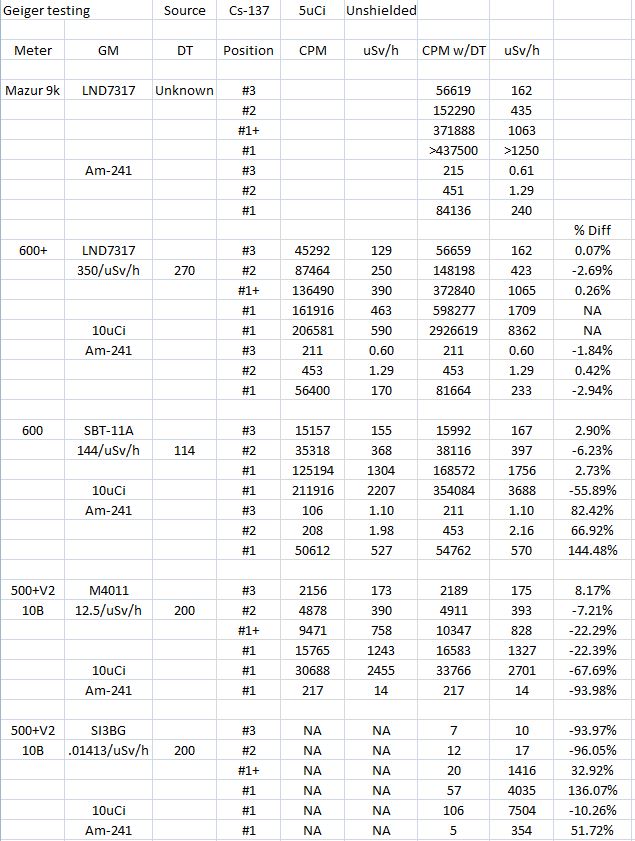
124039 bytes
So halting at this point what can I say about calibration and meter choices?
1) Dead time is used by other commercial manufacturers and enables calibration to broadband radiation types and energies acceptable to government standards.
2) While counts is counts, different tubes are not going to read the same, and any meter comparison needs to have same tube to even start to get valid comparisons.
3) Different tubes not only have different conversion factors, but those factors are dependent on the tube's response to different radiation type and energy and really needs to be filtered for your purposes.
4) For most sensitive applications such as food or surface contamination the pancake mica window tubes are best (600, 600+). In a bit of a surprise the SBT-11A was more sensitive to alphas than the 7317, but the 7317 is the gold standard for pancake tubes in the US and used in the highest end field survey meters.
5) At the same time the 600+ has essentially the same response as a meter that is more than twice as expensive and is fully capable of meeting calibration requirements of governmental entities.
6) For background, and really a meter that exceeds the pancake tube applications, the M4011 based 500 and the dual tube 500+ provide a sensitive meter for everyday monitoring; and the 500+ addition of the SI3BG provides an amazing range of measurement, adding incident response levels to its range. This meter is truly unique and an amazing value considering other meters in its price range.
Most importantly, while I tried to be consistent these are not very rigorous comparisons. The meters as they come from GQ certainly will make you aware of changes to the radiation environment rather quickly, and since really only the SI3BG is an incident level response tube, the others would likely be saturated well before you get to something that is actually harmful, according to the US EPA.
|
Stargazer 40 |
Edited by - Stargazer 40 on 11/26/2018 06:05:00 |
 |
|
| Reply #14
Stargazer 40
    
USA
431 Posts |
 Posted - 11/15/2018 : 13:17:25 Posted - 11/15/2018 : 13:17:25


|
Shielding for everything but gammas is easy with the little flat lead sheets that the source disks come in. The lead is 3mm thick and reduces the gammas by 10% while stopping all the betas and alphas. So simply covering the disk with one of the plates does the job. Now we see the benefit of single type of radiation going into the comparison. The most significant thing is changes to the SBT-11A conversion in the 600, and the M4011 conversion in the 500 and 500+. Here is the new table for gammas only. Still need to add the SI3BG, but the numbers are much more consistent. New conversion for the SBT-11A is 144CPM/uSv/h (.00694), and for the M4011 is 55CPM/uSv/h (.0182). GQ ships with SBT-11A at 300CPM/uSv/h and 154CPM/uSv/h for the M4011, so some differences but much closer than we saw with broadband radiation measurements above.
And for completeness sake I will go back and update the broadband table for the new conversion numbers and response after I get the SI3BG added to the gamma table.
Image Insert:
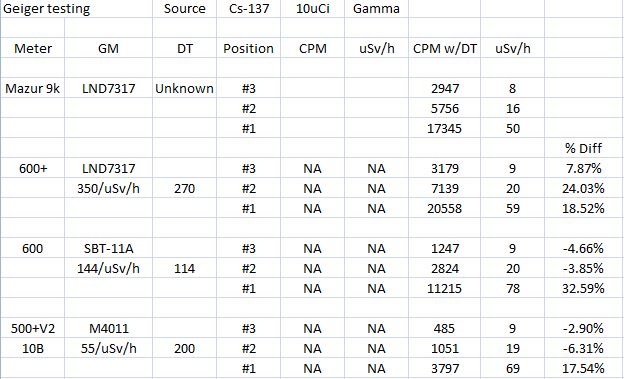
52196 bytes
There are differences between the Mazur 9k and the 600+, and I'm sure that there is variation among these tubes as well, but I don't plan on modifying the 600+ calibration any further at this time. The 600 and 500+ are showing deviation from the 600+. Good match at Positions #2 and #3, and Position #1 is higher for both and likely tube geometry effects. So I like this comparison better than the last and will only post screen shots for it instead of the remainder of the table above.
Mazur 9k
Image Insert:
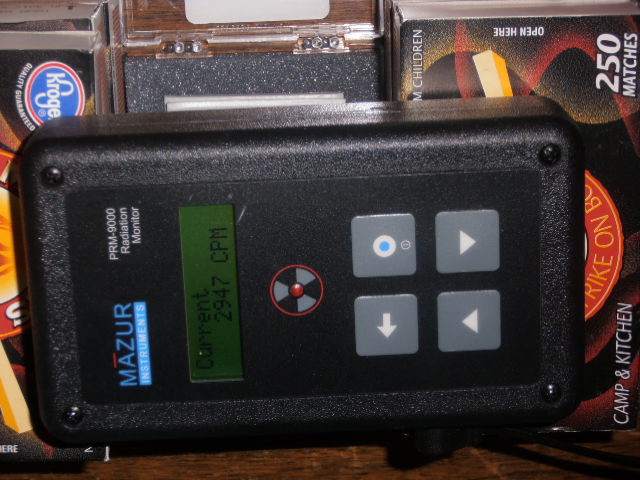
76976 bytes
Image Insert:
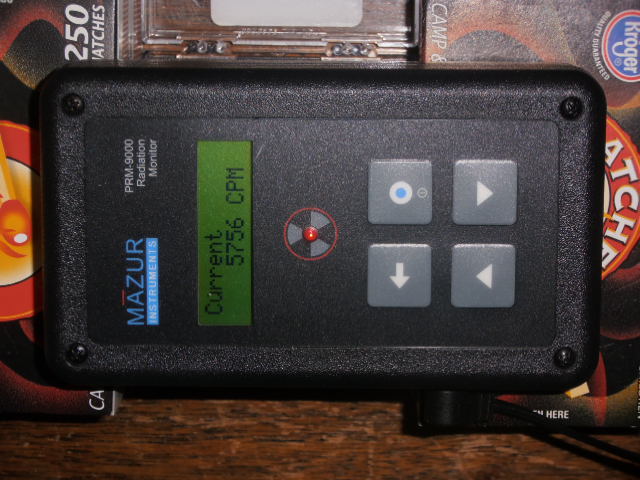
73781 bytes
Image Insert:
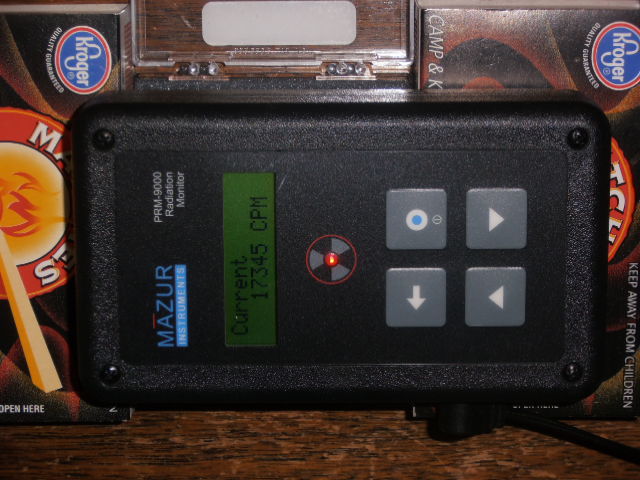
74452 bytes
600+
Image Insert:

75982 bytes
Image Insert:
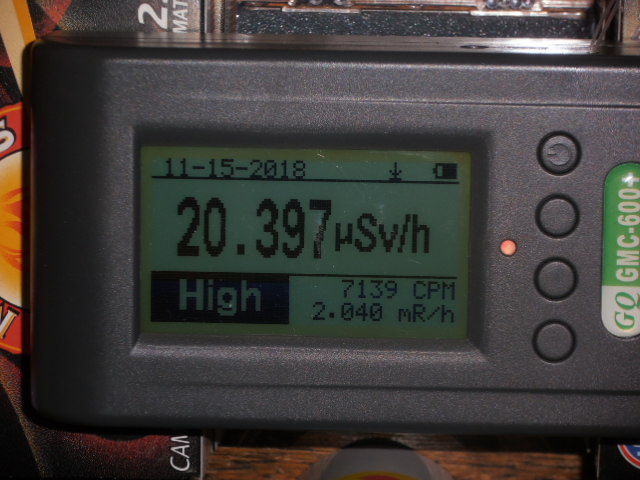
73955 bytes
Image Insert:
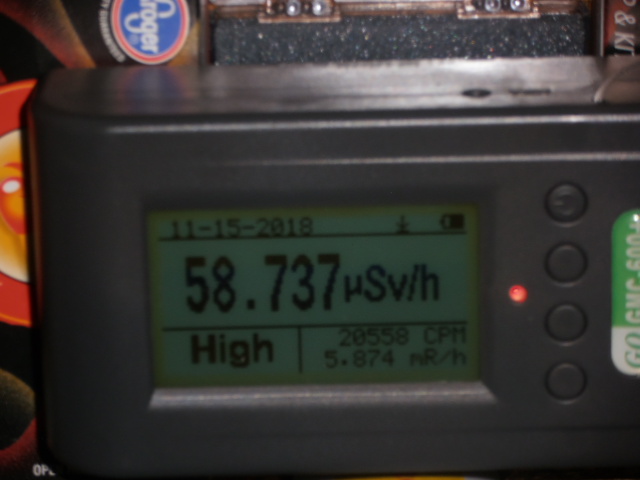
79349 bytes
600
Image Insert:
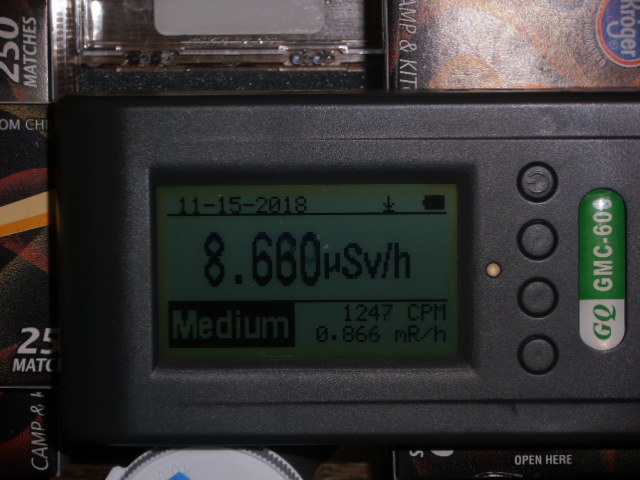
76047 bytes
Image Insert:
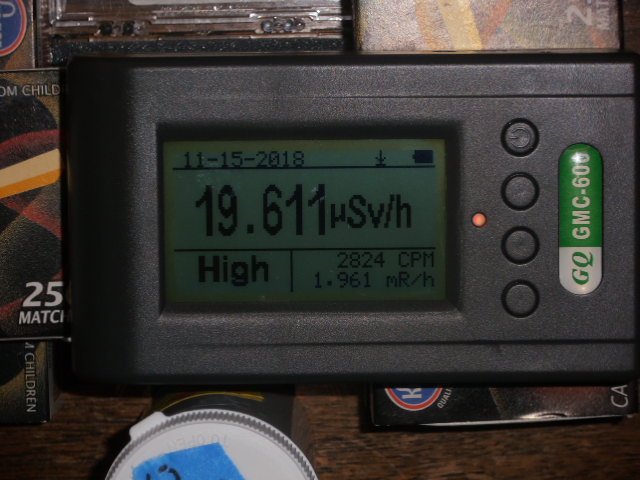
74893 bytes
Image Insert:

73970 bytes
500+ M4011
Image Insert:
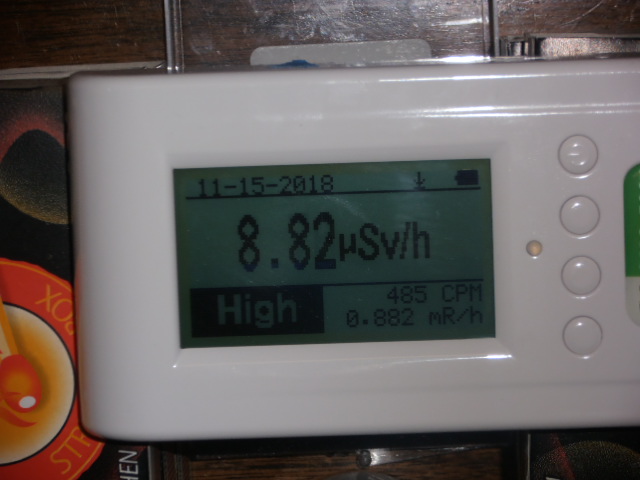
77479 bytes
Image Insert:
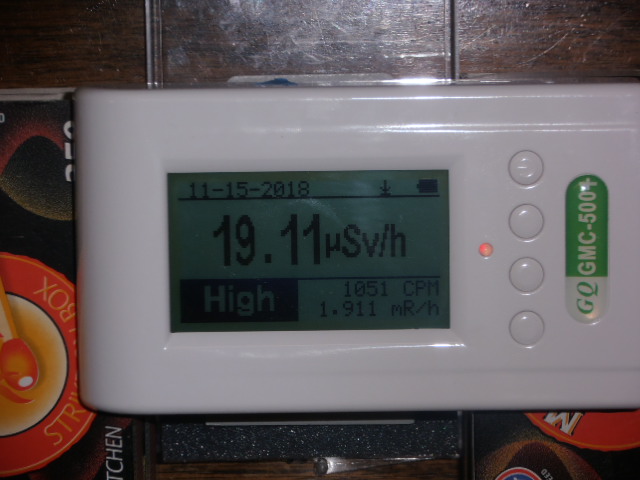
76284 bytes
Image Insert:
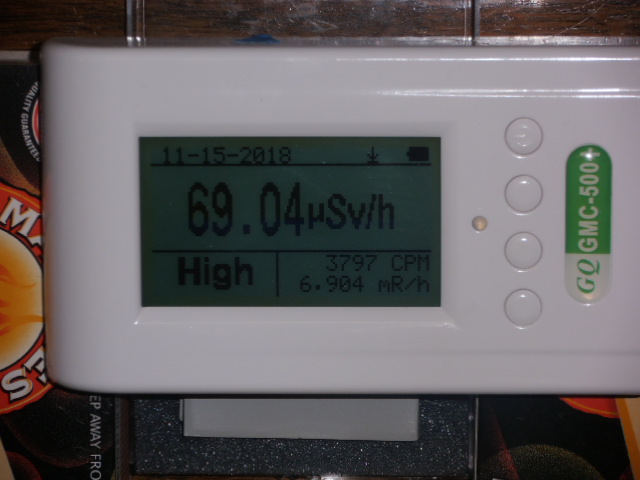
76300 bytes
|
Stargazer 40 |
Edited by - Stargazer 40 on 11/15/2018 16:00:45 |
 |
|
| Reply #15
ikerrg
    
United Kingdom
334 Posts |
 Posted - 11/15/2018 : 15:17:41 Posted - 11/15/2018 : 15:17:41


|
Thanks for the detailed measurements. Now we are talking! The unique radiation type (photons), coming from the gammas and the x-rays from the bremsstrahlung of betas, are making all the tubes react more consistently. When you add the SI-3BG to the table you should see that position #1 is not much more different to the other positions (apart from the obvious radiation increase due to the inverse square law), because of the relative effective size of the tube. By the way, how did you calculate the 17.58% for the M4011 in position #1?
There is still one thing, and it is that the energies of the photons coming from the Cs-137 are diverse (the radiation is not monochromatic), and I think that the different tubes behave differently (in terms of sensitivity) to different radiation energies. I will try to do something about that with the Am-241. In fact, knowing the specific activity in Bq, I should be able to estimate the actual radiation crossing the tubes by geometry and give a real idea of what should be the accumulated dose in Grays and what is the calibration factor to achieve that in both tubes.
|
 |
|
| Reply #16
Stargazer 40
    
USA
431 Posts |
 Posted - 11/15/2018 : 16:06:27 Posted - 11/15/2018 : 16:06:27


|
The calculation is the same for the GQ meters compared to the 600+. The raw (not rounded in table) uSv/h is divided by the same position raw uSv/h for the 600+ minus 1 and expressed as percent. So the number is exact for the raw unrounded numbers (which are available on the screen images). This exercise was much more gratifying than the much more intensive broadband one.
Oh, and the SBT-11A correction has been corrected in table and text. It is 144CPM/uSv/h and .00694 |
Stargazer 40 |
Edited by - Stargazer 40 on 11/15/2018 16:09:15 |
 |
|
| Reply #17
Stargazer 40
    
USA
431 Posts |
 Posted - 11/15/2018 : 17:51:08 Posted - 11/15/2018 : 17:51:08


|
Here is the SI3BG addition to the table. The new correction factor for the primarily gamma tube is .881CPM/uSv/h or 1.135. This is showing same bump at Position #1 as other tubes, but otherwise the fit is good despite the low count rates.
Image Insert:
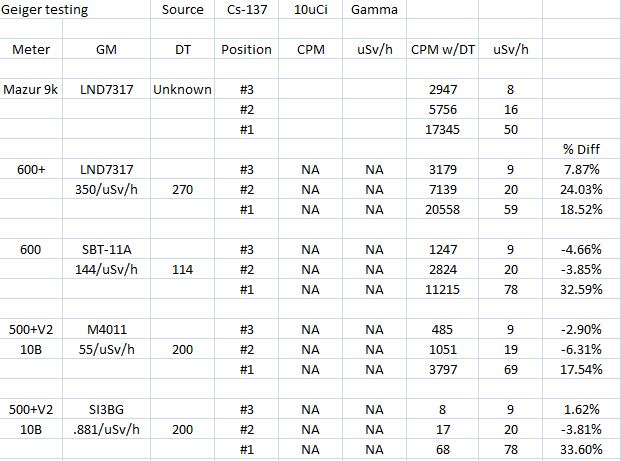
62772 bytes
SI3BG screen images
Image Insert:

77647 bytes
Image Insert:

79283 bytes
Image Insert:

77228 bytes |
Stargazer 40 |
Edited by - Stargazer 40 on 11/15/2018 20:29:56 |
 |
|
| Reply #18
ikerrg
    
United Kingdom
334 Posts |
 Posted - 11/16/2018 : 01:36:26 Posted - 11/16/2018 : 01:36:26


|
| Could you measure the distance from the source to the detector on each of the positions? (or the thickness of the source box and the thickness of the matches boxes). The ratio between CPMs at different positions show that a geometry factor is key if we want to be able to compare the different devices/tubes. I would like to check how the different measured intensities match the geometric inverse square law. |
Edited by - ikerrg on 11/16/2018 01:44:52 |
 |
|
| Reply #19
Stargazer 40
    
USA
431 Posts |
 Posted - 11/16/2018 : 05:03:51 Posted - 11/16/2018 : 05:03:51


|
@ikerrg,
Each matchbox is 29mm tall. The post it notes pad is 10mm thick. The source container with the recessed disk punch is 12mm off the table. The disk is roughly 3mm thick so center of source from table would be 13.5mm. The tubes are some distance from the outside edge of the case, so estimated another 3mm.
Position #3 is (3 * 29 + 3) - 13.5 = 90 - 13.5 = 76.5mm
Position #2 is (2 * 29 + 3) - 13.5 = 61 - 13.5 = 47.5mm
Position #1+ is (1 * 29 + 10 + 3) - 13.5 = 42 - 13.5 = 28.5mm
Position #1 is (1 * 29 + 3) - 13.5 = 32 - 13.5 = 18.5mm
By the way, with these gamma measures and calibration we are now only 15% below ullix's estimate of the difference in sensitivities of the M4011 and SI3BG. 55/.881 is 62.5X and ullix measured 72X. Given variation in individual tube sensitivities, that is very good agreement with his estimate.
. |
Stargazer 40 |
Edited by - Stargazer 40 on 11/16/2018 05:46:06 |
 |
|
| Reply #20
ikerrg
    
United Kingdom
334 Posts |
 Posted - 11/16/2018 : 10:09:13 Posted - 11/16/2018 : 10:09:13


|
Thanks for the dimensions, Stargazer_40.
First of all, it is odd the difference between Mazur 9k and 600+ (just in CPM) for the gamma source. They have the same tube and the setup is similar, so they should be measuring much more identical counts, like they were doing for the unshielded Cs-137 source. That makes me wonder if there is any other adjustment in the Mazur 9k calibration inside the firmware that messes with the CPM besides the dead count, to make the response as expected to a calibrated (not shielded) Cs-137 source.
With regards to the distance, I calculated the expected radiation (in CPM) based on the position #3 measurement (most homogenous radiation on the tubes) and considering a point source (not true, but approximately true for long distances).
Image Insert:

10587 bytes
You can see in the table that the calculation works quite well for position #2, but it fails miserably for position #1. That is because the disc cannot be considered a point source at all at the closest distance, and a geometrical integration would be needed to estimate the radiation flux that it is not crossing the tubes compared to the ideal point source case. That is why the measurements are lower than the calculations the closer you are to the radiation source, because a point source with the same activity should create a radiation field much more intense at position #1 than a disc (where the radiation is more distributed). For long distances, both a disc and a point would be similar from the radiation flux point of view.
If you could use the Am-241 source, which should be more concentrated in a smaller volume, the results should be much more predictable, but you need to combine several Am-241 pellets in the same small volume. I have received the 5 smoke detectors today, but I still have to wait for the lead strip that I want to use to enclose the 5 tiny radiation dots in a small volume without any risks of them becoming airborne!
|
 |
|
| Reply #21
Stargazer 40
    
USA
431 Posts |
 Posted - 11/17/2018 : 04:05:00 Posted - 11/17/2018 : 04:05:00


|
Thanks ikerrg for going through the calcs. I think for the differences in counts between the Mazur and the 600+ that ullix might jump in here and talk about Poisson distributions being required and I haven't collected data for that. So I need to take this to another level. For now though the overriding factor is that the two counters are showing the same readings for Cs-137 broadband, and that is what I believe will be used to certify here in US (but I will check further with that).
These commercial educational sources are about 4mm-5mm in diameter (and likely smaller). They are likely smaller than the Am-241 chunk that is in the smoke detector. The small quantity is sandwiched between two plastic disks of one inch in diameter in the center and you can see the dimple at the center of the plastic disk. It is a sealed unit. I will post a picture but can't get that out here at this time. |
Stargazer 40 |
 |
|
| Reply #22
ZLM
    
1271 Posts |
 Posted - 11/17/2018 : 11:13:21 Posted - 11/17/2018 : 11:13:21


|
| Great testing. Thanks to Stargazer 40. |
 |
|
| Reply #23
EmfDev
    
2314 Posts |
 Posted - 11/19/2018 : 14:08:03 Posted - 11/19/2018 : 14:08:03


|
@Stargazer_40 @ikerrg,
Thank you guys for your hard work and support for the GMC units.
I would like to ask what would be your final calibration factor/dead time that we should use if we put these result to the firmware. |
 |
|
| Reply #24
ikerrg
    
United Kingdom
334 Posts |
 Posted - 11/19/2018 : 15:09:11 Posted - 11/19/2018 : 15:09:11


|
Stargazer_40 did a great job with that battery of tests, especially when matching the dead time and calibration factor between the Mazur and the 600+. For the LND7317 tube, the values seem to be 350 CPM/(uSv/h) and 270 microsec. to match an actually calibrated device to an unshielded Cs-137 source (mixed betas and gammas). But that does not mean that the dose rate in uSv/h is valid for any radiation.
For the M4011, the equivalent numbers seem to be 12.5 CPM/(uSv/h) and 110 microsec for an unshielded Cs-137 source.
However, for the 500+ tubes I would calibrate them with the results to the gamma radiation (especially for the SI-3BG). To find the best numbers, given the low intensity of the gammas, the average of a proper Poisson distribution is needed, for which long recording times are required. However, the preliminary numbers obtained look sensible to me. The M4011 is much less sensitive to gammas than to betas, resulting in 55 CPM/(uSv/h). The number that everybody accepts for that tube is around 153 CPM/(uSv/h), but that is a mixed response to betas and gammas for two sources (Co60 and Cs137 I believe). For the SI-3BG, the number of 0.881 CPM/(uSv/h) seems to be also sensible, achieving a ratio between the two tubes (M4011 and SI3BG) very similar to what ullix obtained several months ago (as Stargazer_40 already noted). But please note that all these calibrations to uSv/h are based on Mazurís calibration, which is only for an unshielded Cs-137 source. A test using the geometry (view factors, etc.) and the actual energy deposition from a calibrated source would be needed to get a calibration factor for that source.
As I have said many times, we cannot find a unique number for the calibration of any of these tubes that can be valid for all kinds of radiations (types and energies). We have to decide which reference to use (unshielded Cs-137, 0.7 MeV gammas from Cs-137, 60 keV gammas from Am-241, etc.) and then do a proper calculation with a known calibrated source at the distance where the tube is located.
The only way to be accurate in the counters would be to have a menu in the firmware where the user can select what standard calibration to use (Cs-137, Co-60, custom, etc.) and then automatically set the values to the ones given by empirical data for the tube.
|
 |
|
| Reply #25
Stargazer 40
    
USA
431 Posts |
 Posted - 11/20/2018 : 08:09:56 Posted - 11/20/2018 : 08:09:56


|
I think it depends on the use of the meter. I am First Responder oriented and I think the Mazur calibration is focused on that as well. What I would like though is a number that shows a degree of similarity between meters (that is really pie in the sky thought as each tube has it's pluses and minuses for different radiation types and energies). So my personal approach is to use the numbers that provide the best match to a standard like the Mazur 7317 GM tube in the 9000, at least across its range of .125-1250uSv/h. I think I achieved that with the numbers quoted by ikerrg above. The other tubes/meters tested are most similar with gamma response to the 600+. Ikerrg makes a great point with the accepted response of the M4011 as 153CPM/uSv/h. I also have no confidence in the 12.5CPM/uSv/h - 110usec, as I think it simply is too low. The compromise number for me is the 55/CPM, 200usec. I will stand by the .881 CPM/uSv/h number for the SI3BG (when paired with the 55CPM/uSv/h) as I think it is well supported by ullix's very credible number although might be unique to my copy. It's clearly a gamma tube and the numbers are for that. The 55CPM for the M4011 is more conservative number than 153CPM so for high counts dead time might be reduced. However I need more work on the dead time for the M4011 and the SI3BG. I think for the 600 and the SBT-11/11A, I'd go with the numbers that matched it to the 600+ in the broadband Cs-137 table. It is less responsive to broadband Cs-137 and more than twice as sensitive to alphas.
We might be a bit premature to look at numbers across the board (make standard in new deliveries), except for the 600+. I do want to go back and take the numbers on the gamma chart and do all the Cs-137 broadbands with M4011 and SI3BG with those and see if dead time changes might provide a better match. Will try to get that done over the long weekend.
|
Stargazer 40 |
Edited by - Stargazer 40 on 11/20/2018 10:55:41 |
 |
|
| Reply #26
ikerrg
    
United Kingdom
334 Posts |
 Posted - 11/20/2018 : 11:13:11 Posted - 11/20/2018 : 11:13:11


|
I agree, Stargazer_40. It is a difficult question to get a simple answer. So probably having the tubes calibrated for different sources and then being able to select the calibration in the firmware (depending on the source to measure) would achieve the best compromise. I think we should focus in characterizing the SI3BG, which is clearly only for gammas and it is so tiny that it should be easy to consider it totally immersed in a homogeneous field for any source and distance.
In order to create that powerful gamma source I am trying to combine the 5 smoke detectors into a point source, but when disassembling them I probably reached to a show stopper point. The radioactive Am241 thin foil seems to be mounted in a steel holder, 5 mm diameter and 1.5 mm thick, opened on the top to be able to release the alphas that create the ionization chamber. The steel rim has been punched to hold the Am241 foil inside.
Image Insert:
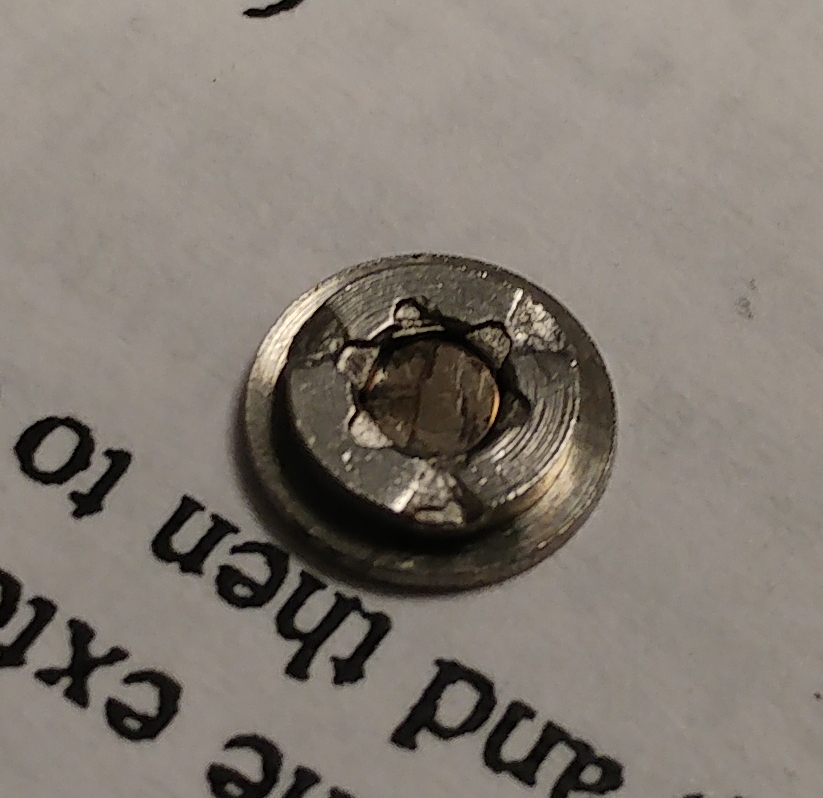
229892 bytes
I cannot risk trying to release the Am241 foil from the steel case by filing the steel or trying to bend it, because I might scratch the foil and it might become airborne. I do not know the mechanical properties of the Americium oxide alloyed with gold (brittle, etc). Iíll think about something, but it just looks dangerous. |
Edited by - ikerrg on 11/20/2018 11:16:53 |
 |
|
| Reply #27
Stargazer 40
    
USA
431 Posts |
 Posted - 11/20/2018 : 11:33:50 Posted - 11/20/2018 : 11:33:50


|
| I think they made it hard to remove on purpose of course and about the best you would be able to do is gather them all together in a less than 15mm circle to approximate a point source for a bit of distance. And wouldn't it take seven total to make a circle around one in the center? |
Stargazer 40 |
 |
|
| Reply #28
ikerrg
    
United Kingdom
334 Posts |
 Posted - 11/20/2018 : 11:52:34 Posted - 11/20/2018 : 11:52:34


|
| @Stargazer_40: Maybe, but I could only order a batch of 5 and I didn't know what they looked like or their size until I disassembled the first one. |
 |
|
| Reply #29
EmfDev
    
2314 Posts |
 Posted - 11/21/2018 : 11:04:52 Posted - 11/21/2018 : 11:04:52


|
| Maybe for now we can use the 600+ data. |
 |
|
| Reply #30
Stargazer 40
    
USA
431 Posts |
 Posted - 11/21/2018 : 11:46:57 Posted - 11/21/2018 : 11:46:57


|
@EmfDev - I agree with that at this point. The 600+ is a good match. The 600 data with the SBT-11A/11 is also what I'm leaving on the meters so maybe the 600 too.
|
Stargazer 40 |
 |
|
| Reply #31
EmfDev
    
2314 Posts |
 Posted - 11/21/2018 : 13:08:21 Posted - 11/21/2018 : 13:08:21


|
| Yes if that's ok with you @Stargazer since you did the testing. |
 |
|
| Reply #32
ikerrg
    
United Kingdom
334 Posts |
 Posted - 11/24/2018 : 12:19:23 Posted - 11/24/2018 : 12:19:23


|
I just wanted to show you my latest findings, trying to calculate the dose rates from Stargazer_40ís experiments. I am only going to use the gamma experiments (10 uCi source shielded with 3mm lead). I was doing weird calculations (not very successfully) when I found a free online calculator (there is also a Windows software) that can do that for me, even considering photon scattering in the shielding material. The calculator works for point sources, so I am going to show the results for the SI-3BG tube (designed for gamma) at the three different distances from the source. This tube is also perfect because its size is negligible compared to the distance.
Image Insert:

5577 bytes
You can see that, apart from the nearest measurement (where the source cannot be considered a point), the calibration of 0.48 uSv/h/CPM that Iíve been using since ullix did his KCl experiments with gamma seems to be the most appropriate for the SI-3BG tube inside 660 keV gammas. As this calibration is backed by calculations, and thanks to Stargazer_40 also by measurements, I think GQ should change the default calibration of the SI-3BG tube to 0.48 uSv/h/CPM. The calibration of 1.135 uSv/h/CPM found by Stargazer_40 by fitting to the Mazur9k is not so accurate as it considers that the Mazur9k is calibrated to shielded Cs-137 (only gammas), which is not. The SI-3BG is an only gamma tube and should be calibrated only to that radiation.
By the way, the calculator is here:
www.radprocalculator.com/Gamma.aspx
There are also calculators for betas and bremsstrahlung.
Image Insert:

114523 bytes
@Stargazer_40: Could you tell me the activity of the Am-241 source that you used for the Am-241 tests? That is also only gamma, so it would be interesting to compare.
|
Edited by - ikerrg on 11/25/2018 01:11:03 |
 |
|
| Reply #33
ikerrg
    
United Kingdom
334 Posts |
 Posted - 11/24/2018 : 13:00:03 Posted - 11/24/2018 : 13:00:03


|
And by the way, if you assume that the M4011 is inside a homogeneous field @ position #3 (76.5 mm), the 485 CPM measured by Stargazer_40 correspond to a calibration of 485/3.27= 148, very close to the 153 we already use (i.e. 0.0065). We have to consider that the lead is probably generating lots of bremsstrahlung coming from the betas of the Cs-137, which are contributing to the count rate.
In order to adjust both tubes more accurately, long measuring times would be needed to obtain the average of the CPM with more accuracy, and then use the analytically calculated values to get the calibration factor.
But the SI-3BG @ 0.48 uSv/h/CPM looks definitely the best candidate for the next firmware! And then we would have 2 tubes already well defined (LND and SI-3BG). |
Edited by - ikerrg on 11/24/2018 13:02:53 |
 |
|
| Reply #34
Stargazer 40
    
USA
431 Posts |
 Posted - 11/24/2018 : 20:04:50 Posted - 11/24/2018 : 20:04:50


|
| The smoke detector states <0.9uCi |
Stargazer 40 |
 |
|
| Reply #35
ikerrg
    
United Kingdom
334 Posts |
 Posted - 11/25/2018 : 01:11:40 Posted - 11/25/2018 : 01:11:40


|
I cannot find the reason of the high count rate of the M4011 for the Am-241. You measured 217 CPM, but even subtracting the background (letís say 30 CPM), the resulting count rate is too high for a 0.9 uCi source of Am-241 at 76.5mm. The calculator is reporting 0.0226 uSv/h. I have some possible explanations:
-The position was #1 (18.5 mm), not #3. That would increase the calculator result to 0.387 uSv/h, which added to the background would be very close to the 0.6 uSv/h reported by the 600+ @ position #3.
-The alpha particles are ionizing the air close to the source, creating electrons that are detected additionally to the gammas at 76.5mm. I donít know the energy of the electrons knocked out from the air molecules by the alphas. To avoid that, a plastic + aluminium double shield would be useful (or only the aluminum if the energy of the electrons is not high). 3 mm lead is too much and it will also filter the gammas emitted by the Am-241.
In any case, I need to understand much better the secondary interactions of the main emission to see if the calculator is taking those numbers into account when an isotope is selected as gamma emitter or beta emitter.
|
Edited by - ikerrg on 11/25/2018 01:13:09 |
 |
|
| Reply #36
Stargazer 40
    
USA
431 Posts |
 Posted - 11/25/2018 : 01:50:55 Posted - 11/25/2018 : 01:50:55


|
@ikerrg, I am really quite amazed by your logic here. I went back and checked the picture of the Am-241 and M4011 at 14.04uSv/h and 217CPM. It was indeed at Position #1 and not at Position #3. I am revisiting all my numbers and will update the charts as I relook at these numbers from the gammas compared to broadband Cs-137.
Image Insert:
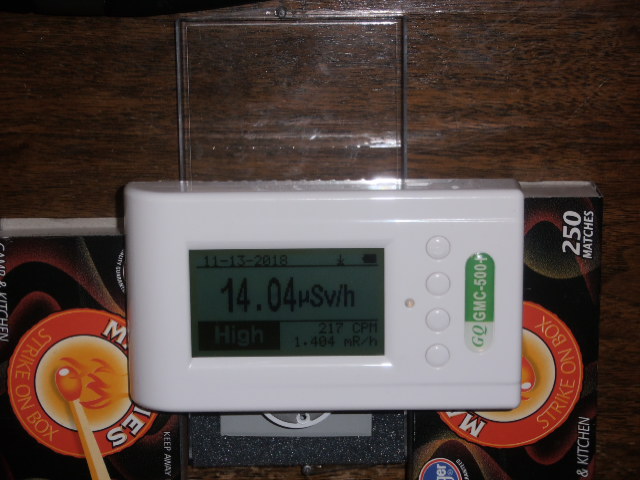
81063 bytes
Thanks for the calculator link. I will read what it says about methodology. Have to say that again that the Cs-137 source is more point-like than not. It is likely no more than 2-3mm in diameter sandwiched between the two plastic discs. |
Stargazer 40 |
 |
|
| Reply #37
Stargazer 40
    
USA
431 Posts |
 Posted - 11/25/2018 : 02:20:25 Posted - 11/25/2018 : 02:20:25


|
| The question I have about this calculator is that it is giving a dose rate based on presumably large tissue area at some distance from the point source. The meters aren't detecting all of that. Indeed if you look at the beta emitter calculator on the same site, it calculates ~10x the dose rate of the calibrated units for dose rate (only does mR/h but mult by 10 to uSv/h). So I think we still are missing the tube geometry aspect, as these calculators are meant to deal with tissue exposure and not to give meter readings? Does that make sense or am I missing something? |
Stargazer 40 |
 |
|
| Reply #38
Stargazer 40
    
USA
431 Posts |
 Posted - 11/25/2018 : 03:52:13 Posted - 11/25/2018 : 03:52:13


|
quote:
Originally posted by ikerrg
And by the way, if you assume that the M4011 is inside a homogeneous field @ position #3 (76.5 mm), the 485 CPM measured by Stargazer_40 correspond to a calibration of 485/3.27= 148, very close to the 153 we already use (i.e. 0.0065). We have to consider that the lead is probably generating lots of bremsstrahlung coming from the betas of the Cs-137, which are contributing to the count rate.
I don't buy this. The braking radiation, like the betas, is likely blocked by the lead shielding, is it not? The only thing coming through the lead is the gammas (unless I am missing something). |
Stargazer 40 |
 |
|
| Reply #39
ikerrg
    
United Kingdom
334 Posts |
 Posted - 11/25/2018 : 08:35:31 Posted - 11/25/2018 : 08:35:31


|
quote:
The question I have about this calculator is that it is giving a dose rate based on presumably large tissue area at some distance from the point source. The meters aren't detecting all of that. Indeed if you look at the beta emitter calculator on the same site, it calculates ~10x the dose rate of the calibrated units for dose rate (only does mR/h but mult by 10 to uSv/h). So I think we still are missing the tube geometry aspect, as these calculators are meant to deal with tissue exposure and not to give meter readings? Does that make sense or am I missing something?
OK, I havenít checked the beta emitter calculations, but I cannot find the units that you specify. It is returning the dose rate in Grays or rads, not Roentgen! At 76.5 mm (position #3) the dose rate of a 5 uCi Cs-137 source is 0.467 mGy/h, which for electrons it would be equivalent to 467 uSv/h, still bigger than the Mazur9k but closer. I donít know how the calibrated dose rate is obtained, as different energy electrons would give different dose rates and the Mazur cannot take that into account, so I donít know who is right (the calculator or the Mazur9k), but I would not blindly accept that it is the Mazur until I understand more about these kind of calculations.
quote:
I don't buy this. The braking radiation, like the betas, is likely blocked by the lead shielding, is it not? The only thing coming through the lead is the gammas (unless I am missing something).
In this you are wrong. The betas are usually shielded with a multilayered shield (first low Z number materials like plastic or aluminium, then high Z number like lead) for a reason. If shielded directly with high atomic numbers (like lead), the interactions between the electrons and the material are massive, and the braking radiation (x-rays, which is the same as gammas) exits the material because it is generated by the scattering of electrons inside the lead, where the remaining thickness to shield the photons is not enough. All this depends on the energy of the betas, the thicknesses of the materials, etc., but in general terms, if the thickness of lead is not enough the radiation could be worse when shielding than when not shielding (because x-rays are much more penetrating than electrons, which cannot fly in air much more than 1 m). See, for example, www.imperial.ac.uk/safety/unsealedsources/story_content/external_files/Radiation-shielding.pdf
|
Edited by - ikerrg on 11/25/2018 08:49:48 |
 |
|
| Reply #40
ikerrg
    
United Kingdom
334 Posts |
 Posted - 11/25/2018 : 08:40:55 Posted - 11/25/2018 : 08:40:55


|
| I forgot to answer to the other question. The radiation dose rate does not depend on the size of the surface where it hits, because the radiation dose units (Grays, Sievert) are J/kg, i.e. they depend on the mass of the object. For an homogenous radiation field, if the thickness of the object or tissue is enough to absorb all the incident radiation, the dose rate is independent of the surface size (more surface yields more energy absorbed, but also more mass to absorb the energy, so the ratio is constant). |
 |
|
| Reply #41
Stargazer 40
    
USA
431 Posts |
 Posted - 11/25/2018 : 09:37:02 Posted - 11/25/2018 : 09:37:02


|
Bravo! Gladly wrong and I learned a lot from your answer. So should I go back and place a plastic sheet between source and lead and do these over?
Also I do like the complexity of this software calculator. Seems a lot to be taken into account.
Thanks |
Stargazer 40 |
Edited by - Stargazer 40 on 11/25/2018 09:55:28 |
 |
|
| Reply #42
ikerrg
    
United Kingdom
334 Posts |
 Posted - 11/25/2018 : 15:02:29 Posted - 11/25/2018 : 15:02:29


|
The problem is that I need to understand much more about these calculations. I am already able to calculate the shielding effect of any material for photons (x-rays or gamma), but I still havenít gone through the same process for electrons. What I know until now is that Cs-137 emits 511.6 and 1173.2 keV betas, and those will produce a spectrum of x-rays with a maximum on 1173.2 keV when shielded by a high atomic number material (they quickly release their energy when braking in the form of EM radiation). Photons at 1173.2 keV are hard to shield, and 3 mm of lead still allows 81% of them to go through! But there would be many different energies in the EM radiation (not only the 511.6 keV or the 1173.2 keV), including the characteristic peaks of the different elements, and therefore all this becomes very complicated to me. That is why I hardly can trust in these "calibrations", which have been done for a specific radioisotope with specific shielding, and that cannot be extrapolated to any other situation. So I cannot yet tell you what thickness of aluminium or plastic to put before the lead to reduce the bremsstrahlung.
With enough time (I do not have too much) and effort I should be able to reproduce the calculations done by the online calculator, and therefore understand their applicability and how to modify them for our purposes. Currently, the calculator is a big black box to me in many of the calculations it does.
You are however free to test different materials and see the differences. If you get a weird result, be sure that it is not nature mocking at you, it is our ignorance what makes it weird.
|
Edited by - ikerrg on 11/25/2018 15:06:16 |
 |
|
| Reply #43
Stargazer 40
    
USA
431 Posts |
 Posted - 11/25/2018 : 15:20:57 Posted - 11/25/2018 : 15:20:57


|
 |
Stargazer 40 |
 |
|
| Reply #44
Stargazer 40
    
USA
431 Posts |
 Posted - 11/26/2018 : 06:10:15 Posted - 11/26/2018 : 06:10:15


|
| I rebuilt the table in Reply #13 above and added it back in. Now will work with the M4011 and SI3BG tubes with what we've learned with gamma only source and see if I can get better match for broadband Cs-137 source. Only reason to do this is if we want to get the 500 series certified at a lab, as that's the source they will use (current understanding). |
Stargazer 40 |
 |
|
| Reply #45
Stargazer 40
    
USA
431 Posts |
 Posted - 11/26/2018 : 20:03:46 Posted - 11/26/2018 : 20:03:46


|
I cranked up the source activity to 15uCi and ran each position with the SI3BG again. I then calculated the dose rate from the Rad Pro website including the shielding. Then I looked at a comparison between the conversion I got when working with the gamma data from the 10uCi source alone, ullix's conversion (.468, not .480), and then calculated the conversion required to get counts to match the Rad Pro dose rate. The average of those was conversion of .600, but minimizing average error got me .525, which is laid out in the three columns. The error for each position is less than 10%.
Image Insert:

29064 bytes
So I think the number for this tube in this 500+ is better modeled at .525 conversion, while the number in ullix's 500+ is better modeled at .468 (roughly 12% difference), and I really don't think my 1.135 number should be used in any event. I think we're closer, but maybe I'll run the SI3BG tube in the other 500+.
Oh, and using ullix's 72 times less sensitive than the M4011 we get 72/.525 = 137.14CPM/uSv/h.
Non of this helps match the unshielded Cs-137 response between meters, but I like where the SI3BG conversion is going.
|
Stargazer 40 |
Edited by - Stargazer 40 on 11/27/2018 04:12:40 |
 |
|
| Reply #46
Stargazer 40
    
USA
431 Posts |
 Posted - 11/27/2018 : 11:36:49 Posted - 11/27/2018 : 11:36:49


|
I added two more SI3BG tubes and made another longer settled measure of the 10B tube. Averaged the CPM and reran the numbers given credence to ikerrg's comments about lack of point source at Position #1 affecting numbers. Trying to balance Positions #2 and #3 I get conversion of .510 and Position #1 has 31% error. So I think these three tubes might be less sensitive than ullix's.
Image Insert:

35842 bytes
We could roughly average in the .468 from ullix's measurements and come up with a final conversion of .490, or ikerrg's .480, or really simplify given the nature of the tube and use .500 uSv/h/CPM. |
Stargazer 40 |
Edited by - Stargazer 40 on 11/27/2018 11:42:11 |
 |
|
| Reply #47
EmfDev
    
2314 Posts |
 Posted - 11/27/2018 : 16:33:49 Posted - 11/27/2018 : 16:33:49


|
| Need some time later to reread all these, been very busy guys. |
 |
|
| Reply #48
Stargazer 40
    
USA
431 Posts |
 Posted - 11/28/2018 : 17:06:36 Posted - 11/28/2018 : 17:06:36


|
| I feel there is some subjectivity at just taking a shot of what I think is a stable CPM reading, especially with the SI3BG. So I will expand the window and use the 10 minute timed count. Display shows the result when you are on the Timed Count screen and the time has expired. If that doesn't show some consistency then I'll go with a longer count to average over. So I think we need to wait a bit longer before zeroing in on a conversion for the SI3BG. If I should do this for some number of hours, let me know. |
Stargazer 40 |
Edited by - Stargazer 40 on 11/29/2018 09:51:17 |
 |
|
| Reply #49
Stargazer 40
    
USA
431 Posts |
 Posted - 11/29/2018 : 15:45:38 Posted - 11/29/2018 : 15:45:38


|
Today I took the 10uCi source and placed one meter at the three positions for three ten minute counts and then averaged the averages. Then minimized the error in percent with the Position #2 and #3 errors less than 10%. For this set of measurements I got a conversion factor of .527uSv/h/CPM. IF we think there is validity to the RadProCalc model from ikerrg's post, then that is the number I would recommend.
Image Insert:

39007 bytes
However, I didn't deduct background from these counts. If we consider 1 CPM as a reasonable background count for this tube, then I can get all three counts under 10% and minimize the error at -.07%. That conversion is .621uSv/h/CPM
Image Insert:

38294 bytes |
Stargazer 40 |
 |
|
| Reply #50
ullix
    
Germany
1189 Posts |
 Posted - 11/30/2018 : 03:35:03 Posted - 11/30/2018 : 03:35:03


|
@Stargazer: this post has gotten too big for me to understand the details, but I want to verify one issue:
Your Cs source does NOT seem to be encased in a big metal holder, like the German standard sources, I had referred to. So, while the German sources do emit only gammas, your source will emit both gammas and betas.
But the definition of activity is only for the Cs decay, and that is a beta-only decay. The gammas do all come from the daughter nuclei. And for 100% of betas you get only 95% of gammas.
In effect, unless you shield all the betas, you should get up to 10+9.5=19.5ĶCi of radiation from your nominal "10ĶCi Cs137" source!
If all betas are shielded, and since the source's activity is specified to only +/-20%, this extra 5% difference will barely matter but might be included for completeness.
Not sure about the other sources.
|
 |
|
| Reply #51
Stargazer 40
    
USA
431 Posts |
 Posted - 11/30/2018 : 08:38:46 Posted - 11/30/2018 : 08:38:46


|
@ullix, sorry for any confusion. I was trying to find a more credible way to work toward a better conversion for the SI3BG tube. Concerning the shielding, there is a 3mm lead plate about 2" square on top of the 1" disk containing the source sample (about 1mm diameter in middle). the detector is above that. ikerrg has said that there is likely some braking radiation coming off the interactions with the heavy metal shield, but I thought the lead would stop any betas. Maybe it is generating more through the braking interaction. Concern that we are seeing more than gammas is minimized a bit further because the tiny little GM tube in the SI3BG is wrapped by a coil of wire between its supports (perhaps this is the cathode as well).
I will further investigate the braking radiation as I have just received a sheet of 11mm thick plexiglass to use ahead of the lead to act as a soft beta shield, hoping to reduce braking radiation generation as ikerrg's shielding article described.
Probably best at this point is taking timed reading of counts rather than guessing at some stable number.
|
Stargazer 40 |
 |
|
| Reply #52
ikerrg
    
United Kingdom
334 Posts |
 Posted - 12/01/2018 : 01:49:06 Posted - 12/01/2018 : 01:49:06


|
With regards to the braking radiation, here you have all the tables and information to do the calculations by yourself: https://www.nist.gov/pml/stopping-power-range-tables-electrons-protons-and-helium-ions
I have used those tables to calculate the stopping power of lead for the Am-241 alpha particles (i.e. helium ions @ 5.5 MeV) and it works! You have to use the ďProjected rangeĒ column and divide it by the density of the material. E.g. for lead, only 16 um will stop 5.5 MeV alphas!
When I have time I would like to do the same with electrons (simple) and then understand the braking radiation emitted in the process of fully stopping. Until now I know that the radiation produced decays linearly up to the maximum energy of the electrons, but the radiation emitted from the material (what we see) has a peak (Bragg peak I think) which depends on secondary interactions between the linear radiation spectrum and the material.
|
 |
|
| Reply #53
ullix
    
Germany
1189 Posts |
 Posted - 12/01/2018 : 02:30:28 Posted - 12/01/2018 : 02:30:28


|
@Stargazer: Sounds ok.
The dominant beta (95%) from Cs137 is ~0.5MeV, and even the high energy betas (5%) are no more than 1.3MeV, so a few mm of plexiglass - 11mm should be plenty - followed by a few mm of lead should do the job.
The reason for this stacked setting to eliminate betas and Bremsstrahlung is explained in the Potty Training, see its chapter including Fig.6.
As you currently seem to not have used the plexiglass, I am curious to see what - if any - difference you get with only the lead, only the plexiglass, and both?
|
 |
|
| Reply #54
ikerrg
    
United Kingdom
334 Posts |
 Posted - 12/01/2018 : 11:49:06 Posted - 12/01/2018 : 11:49:06


|
If you look at the tables in https://physics.nist.gov/PhysRefData/Star/Text/ESTAR.html (Radiation Yield), only about 4% of the kinetic energy of the 0.5 MeV electrons is converted to braking radiation in lead (the rest is heat) when the lead is thick enough to stop the betas. The same number is 8% for 1.25 MeV electrons. And 3 mm lead is quite thick, so it is possible that for that beta radiation, the 3 mm lead are enough to stop the betas and the braking radiation produced by them. In fact, the CSDA range @ 0.5 MeV divided by the lead density (11.35 g/cm3) results in a path length of 0.296 mm in lead, which indicates that the 3 mm of lead are enough if I understood all in the correct way.
In any case, the plastic that you bought, Stargazer_40, is quite useful for learning purposes if you measure your sources with other shielding materials (thinner lead, steel, etc.). |
Edited by - ikerrg on 12/01/2018 11:51:37 |
 |
|
| Reply #55
Stargazer 40
    
USA
431 Posts |
 Posted - 12/12/2018 : 18:09:02 Posted - 12/12/2018 : 18:09:02


|
| Have some new numbers to post based on 10 min average CPMs and plexiglas and lead shielding for gammas only measure for GMC meters. Hopefully will get them out here shortly. |
Stargazer 40 |
 |
|
| Reply #56
Stargazer 40
    
USA
431 Posts |
 Posted - 07/19/2019 : 07:08:07 Posted - 07/19/2019 : 07:08:07


|
| Obviously seven months is not shortly. Got caught up in other stuff and am finally getting back to these tests. Firmware updated in all my GCs so just need to load DT and correction factors and I'll be set. Besides the 10-20 minute average CPMs against my sources, I'll also be testing the Auto Voltage function. I have been looking forward to seeing how that works for a long time (literally). |
Stargazer 40 |
 |
|
| Reply #57
EmfDev
    
2314 Posts |
 Posted - 07/19/2019 : 09:22:51 Posted - 07/19/2019 : 09:22:51


|
| Thanks for coming back Stargazer_40. The Auto Voltage function is still lacking but we hope it functions as it's supposed to. |
 |
|
| Reply #58
Stargazer 40
    
USA
431 Posts |
 Posted - 07/23/2019 : 13:16:10 Posted - 07/23/2019 : 13:16:10


|
| Rereading this thread and getting the most current set of numbers I have recorded. Had a number of tests done, but need to verify that they are annotated adequately for presentation. |
Stargazer 40 |
 |
|
| Reply #59
EmfDev
    
2314 Posts |
 Posted - 07/23/2019 : 13:57:46 Posted - 07/23/2019 : 13:57:46


|
| Thanks for the hard work! Looking forward to the results. |
 |
|
| Reply #60
Stargazer 40
    
USA
431 Posts |
 Posted - 07/23/2019 : 15:07:45 Posted - 07/23/2019 : 15:07:45


|
Well it's not only what I've done before, but all of ullix and ikerrg's suggestions. I am encouraged that GQ implemented a tube voltage readout. Waiting for response from support on how it works.
|
Stargazer 40 |
 |
|
| Reply #61
EmfDev
    
2314 Posts |
 Posted - 07/24/2019 : 09:56:31 Posted - 07/24/2019 : 09:56:31


|
| That's true. You guys made GQ geiger counters much better. |
 |
|
| Reply #62
Stargazer 40
    
USA
431 Posts |
 Posted - 07/26/2019 : 16:15:22 Posted - 07/26/2019 : 16:15:22


|
| Getting GCs hardware upgraded and should make analysis much more convenient. Also getting a couple more Cs137 sources that will expand the energy levels by a factor of two when combined. Will really show the different applicability of the different GQ GCs. |
Stargazer 40 |
 |
|
| Reply #63
EmfDev
    
2314 Posts |
 Posted - 07/29/2019 : 09:34:13 Posted - 07/29/2019 : 09:34:13


|
| Btw, the CPM thresholds are based on the dead time adjusted CPS/M. |
 |
|
| Reply #64
Stargazer 40
    
USA
431 Posts |
 Posted - 07/29/2019 : 15:18:58 Posted - 07/29/2019 : 15:18:58


|
| And I believe that these meters that are Deadtime capable should be shipped with Deadtime Enabled and best numbers to date used for each meter. |
Stargazer 40 |
 |
|
| |
 Topic Topic  |
|

